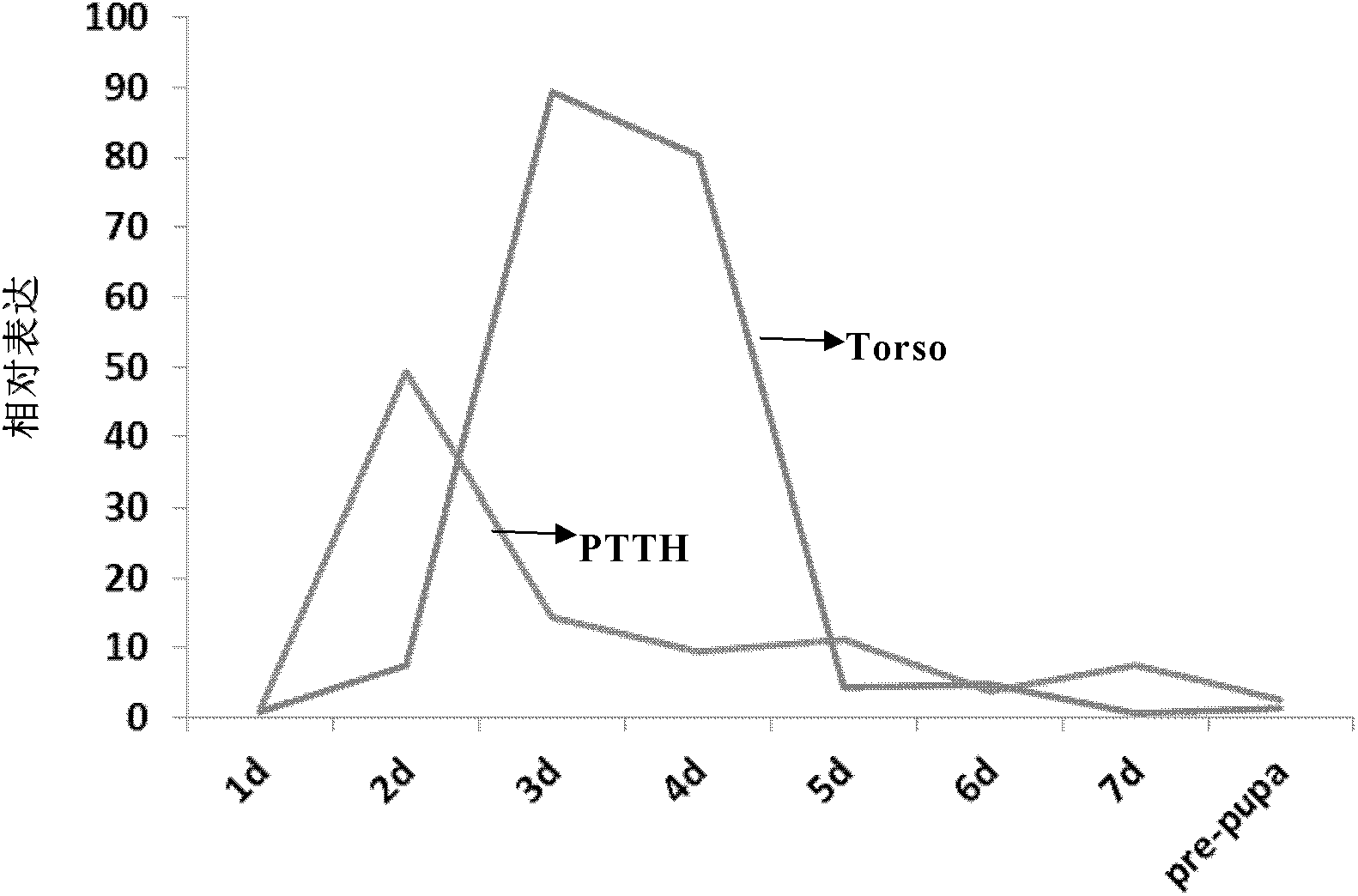RNAi used for regulating and controlling growth of silkworm pupae and application
A pupal stage, positive technology, applied in the fields of biotechnology and agricultural applications, can solve problems such as affecting the quality of silk and consuming large amounts of energy.
- Summary
- Abstract
- Description
- Claims
- Application Information
AI Technical Summary
Problems solved by technology
Method used
Image
Examples
Embodiment 1
[0160] screening target genes
[0161] 1. Extraction of total RNA from silkworm
[0162] Sample: Bombyx mori Dazao strain (P50).
[0163] Methods: The total RNA of silkworm was extracted by conventional Trizol method, and purified by conventional methods. Use DNase to treat the obtained RNA to obtain a concentration ≥ 300 ng / μl, a total amount ≥ 6 μg, and an OD 260 / 280 1.8-2.2 for total RNA samples.
[0164] 2. Isolation of mRNA and synthesis of cDNA
[0165] The mRNA with polyA was isolated with magnetic beads with oligo-dT, and then the first strand of cDNA was synthesized with a random 6-mer and a Superscript II reverse transcriptase kit purchased from Invitrogen.
[0166] 3. Gene amplification and sequencing
[0167] Amplify with primers specific to the target gene, purify the obtained gene fragment, connect it to the PMD-18 vector (manufactured by Takara), transform into a commercially available host cell (Top10 strain), and use the blue-white screening method to ...
Embodiment 2
[0172] dsRNA synthesis
[0173] In this example, the inventors used MAGE kit to synthesize dsRNA that can be used in biological assays.
[0174] use T7Kit (purchased from AMBION, product number AM1334) was used to synthesize target gene dsRNA to obtain dsRNA that can be used for biological assays. Its brief principle is: at first use the total RNA of silkworm larvae tissue as template, obtain cDNA by reverse transcription, then amplify the structural domains of two genes with primers (see Table 1), purify its products, and use the purified products as Template, using the kit for in vitro transcription, after obtaining dsRNA, removing the DNA in the product, and performing purification to obtain the desired dsRNA.
[0175] The specific operation steps are as follows: use the DNA sequences of the two gene domains obtained above as templates, and operate according to the instructions in AM1334Kit:
[0176] 1) In vitro transcription to obtain dsRNA
[0177]
[0178] Add RN...
Embodiment 3
[0184] Applications of dsRNA
[0185] In this example, the inventors prepared the two kinds of dsRNA obtained in Example 2 into aqueous dsRNA solutions with a concentration of 200 ng / μl. 300 μl of each dsRNA aqueous solution was sprayed on mulberry leaves and fed to silkworms once a day for 5 consecutive days. Three groups of repeated experiments were set up, each group used 30 silkworms, and the dsRNA effect was identified every day.
[0186] The results showed that compared with the EYFP gene
[0187] (1) The dsRNA targeting two target genes (PTTH and Torso genes) has a lethal effect on silkworms in the pupal stage. Among them, in the dsRNA PTTH group, there were 20, 22 and 23 dead silkworms in the pupal stage, respectively, with an average of 21.7 , the mortality rate reached 72.3%. In the dsRNA Torso group, there were 19, 21 and 23 dead pupal silkworms in the three groups, with an average of 21, and the mortality rate reached 70%.
[0188] (2) dsRNA targeting two target ...
PUM
| Property | Measurement | Unit |
|---|---|---|
| molecular weight | aaaaa | aaaaa |
Abstract
Description
Claims
Application Information
 Login to View More
Login to View More - R&D
- Intellectual Property
- Life Sciences
- Materials
- Tech Scout
- Unparalleled Data Quality
- Higher Quality Content
- 60% Fewer Hallucinations
Browse by: Latest US Patents, China's latest patents, Technical Efficacy Thesaurus, Application Domain, Technology Topic, Popular Technical Reports.
© 2025 PatSnap. All rights reserved.Legal|Privacy policy|Modern Slavery Act Transparency Statement|Sitemap|About US| Contact US: help@patsnap.com



